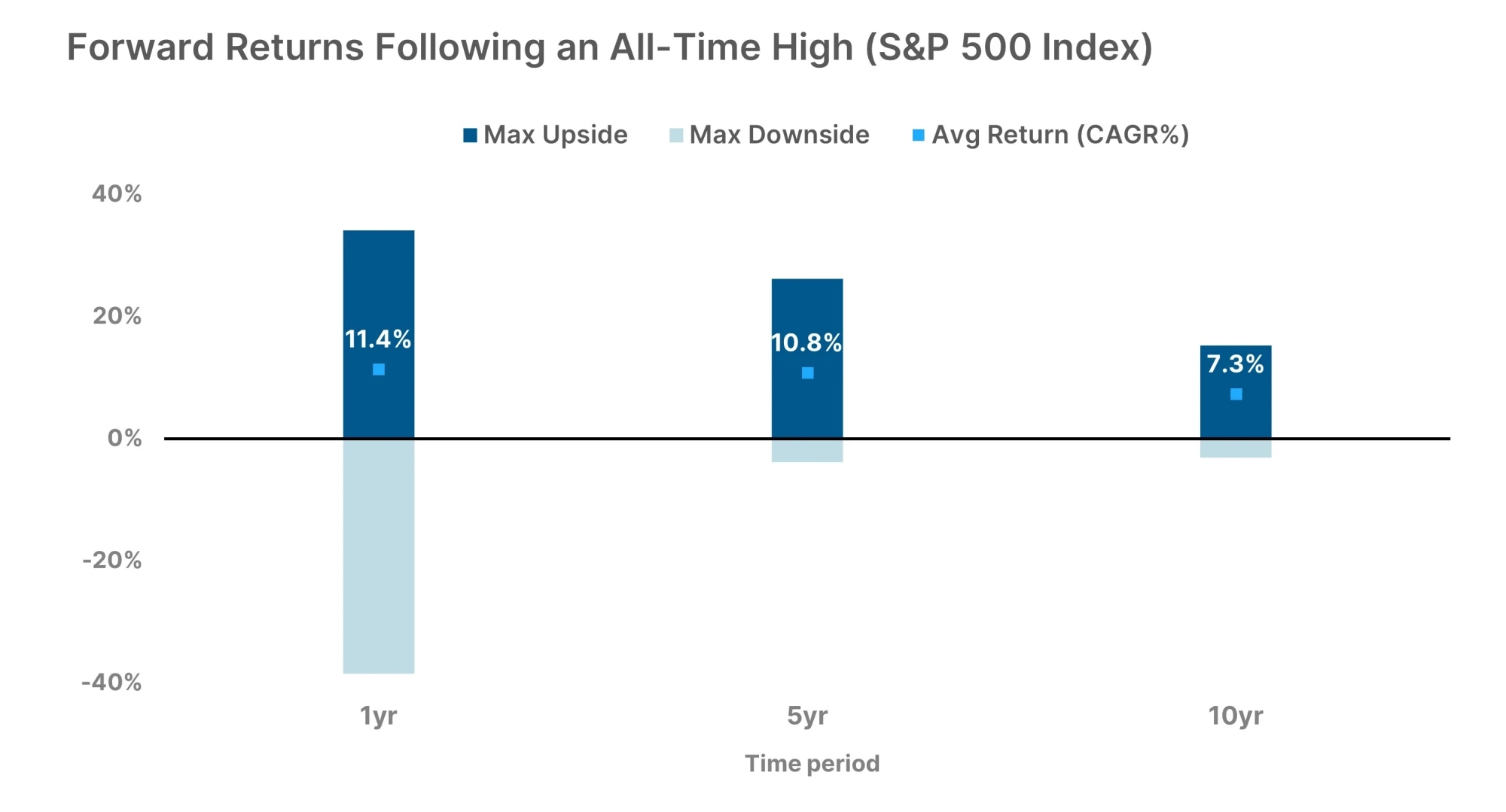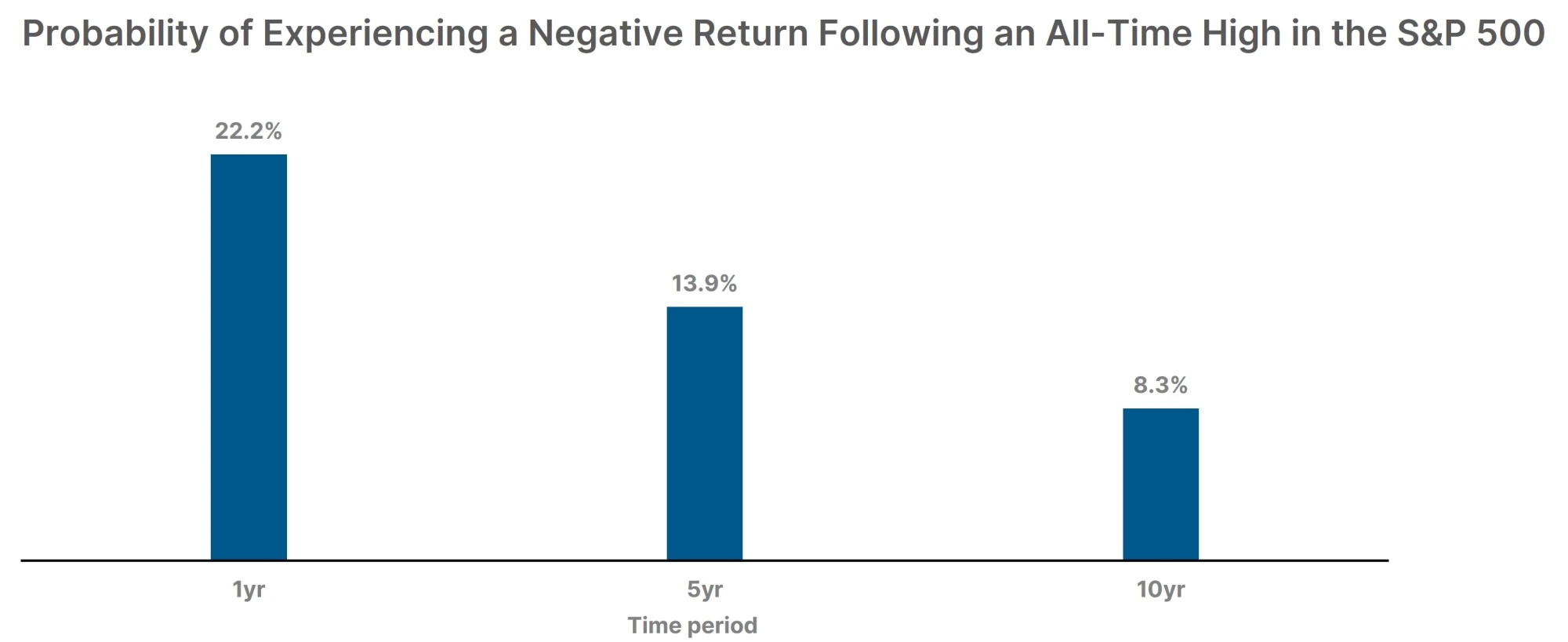Fear Of Market Highs? A Guide To Investing During Market Peaks
02/03/2025
Just as climbers rely on proven techniques and proper equipment, successful investors can navigate market peaks using time-tested strategies rather than trying to time the perfect moment.
Just as some people feel dizzy looking down from a skyscraper or freeze at the edge of a cliff, many investors experience unease when markets reach new heights. This fear of investing at market peaks often leads to paralysis, causing investors to miss out on potential gains while fixating on possible downsides.
Understanding Market Peak Psychology
Our natural aversion to loss makes investing at market highs particularly challenging. Like imagining the worst when peering over a ledge, investors often picture an imminent market crash when stocks reach new peaks. This fear, combined with the illusion that we can time the market perfectly, can lead to missed opportunities and suboptimal investment decisions.
The Reality of Market Peaks
Historical Performance After Market Peaks
Historical data tells a different story than what our fears might suggest. Consider these insights:
The S&P 500 Index has reached 57 all-time highs in the past year alone—above the long-term median, but not unprecedented. Since 1950, approximately 6.7% of trading days have seen the market at record levels.
Looking at returns following market peaks reveals an encouraging pattern. See the analysis of the S&P 500 Index since 1989 in the first chart, which shows that investing at market highs can still lead to solid returns over time.

Sources: Refinitiv, Bloomberg LP. Data for S&P 500 Index calculated from 1989-2024 in U.S. dollars before fees, transaction costs, and taxes. Note: you cannot invest directly in an index, and past performance is no guarantee of future performance. Avg Return (CAGR%) = Average Compound Annual Growth Rate (%) for the periods provided.
As the investment horizon lengthens, the likelihood of negative returns actually decreases, reflecting the market’s long-term upward trajectory.
The True Cost of Waiting
The desire to wait for a "better" entry point often leads to missed opportunities. Historical examples from the S&P 500 Index highlight this reality:
- After the Black Monday crash of October 1987, investors who stayed the course saw a 12.4% gain in one year and a 67% increase over five years.
- Following the 2000 Dot-Com Bubble, the market recovered to deliver annualized gains of around 3% by 2005.
- Even after the pre-COVID-19 peak of February 2020, the market rebounded 16% in one year and delivered over 30% cumulative growth in three years.
Why Market Timing Falls Short
Attempting to time the market is virtually impossible, even for professional investors for several key reasons:
- Market Unpredictability: Market timing requires two perfect
decisions: when to exit and when to re-enter. Markets can remain unpredictable
longer than investors expect, making both decisions extraordinarily difficult to
get right.
- The Price of Poor Timing: Missing just 10 of the best market
days over a long period can significantly impact returns. Beyond this, frequent
trading generates transaction costs and potential tax liabilities that can erode
long-term returns.
- Our Own Behavioural Biases: Loss aversion, overconfidence, and
recency bias often cloud judgement. The illusion of control in market timing can
lead to anxiety over daily market movements and ultimately result in poor
investment decisions based on short-term patterns rather than long-term
fundamentals.
- Hidden Opportunity Costs: While waiting for the “perfect” moment, investors often sit in cash, earning minimal returns while inflation erodes purchasing power. This focus on market timing can distract from more important aspects of financial planning and potentially compromise long-term financial goals.
Smart Strategies For All Market Conditions
1. Dollar-Cost Averaging (DCA)
By spreading investments over time regardless of market conditions, you can reduce the impact of short-term volatility and overcome the psychological barriers of investing at highs.
2. Focus on Time in the Market, Not Timing the Market
Data shows the probability of experiencing negative returns following market highs decreases significantly as time passes (second chart). This underscores the importance of maintaining a long-term perspective.

Sources: Refinitiv, Bloomberg LP. Data for S&P 500 Index from calculated from 1989-2024, in U.S. dollars before fees, transaction costs and taxes. Note that you cannot invest directly in an index and past performance is no guarantee of future performance. Probability of a negative return calculated as number of observed periods of forward negative returns following an all-time high divided by the total number of observations.
3. Strategic Diversification
Spread investments across various asset classes, sectors, and geographies to mitigate risk and potentially enhance returns.
4. Systematic Rebalancing
Regular portfolio rebalancing helps lock in gains while keeping your investments aligned with your goals and risk tolerance.
Embrace the Heights
Think of investing like mountain climbing—the view from the top can be spectacular, but only if you're willing to make the ascent. Just as climbers rely on proven techniques and proper equipment, successful investors can navigate market peaks using time-tested strategies rather than trying to time the perfect moment.
Don't let the fear of heights keep you grounded. Every investor's goals, time horizons, and risk tolerance are unique, which is why we help build portfolios that align with your personal circumstances and long-term objectives while letting the power of time in the market work for you.